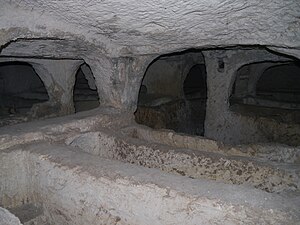St. Paul's Catacombs
 |
|
| Location | St. Agatha Street, Rabat, Malta |
|---|---|
| Coordinates | 35°52′50″N 14°23′51″E / 35.880690°N 14.397610°ECoordinates: 35°52′50″N 14°23′51″E / 35.880690°N 14.397610°E |
| Type | Catacombs |
| Public transit access | Buses 51, 52, 53 from Valletta terminus. |
| Website | www.heritagemalta.org |
St. Paul’s Catacombs are some of the most prominent features of Malta’s paleochristian archaeology. The archaeological clearing of the site has revealed an extensive system of underground galleries and tombs dated from the fourth to the ninth centuries AD.
The site was first fully investigated in 1894 by Dr. Antonio Annetto Caruana. It is now managed by Heritage Malta.
Two catacombs are open to the public, but these are only a small part of the entire St. Paul's and St. Agatha’s complex.
St. Paul’s catacombs are part of a large cemetery once located outside the walls of the ancient Greek city of Melite, now covered by the smaller Mdina and Rabat. It also comprises the catacombs of Saint Agatha, San Katald, St. Augustine and many others.
The cemetery probably originated in the Phoenician-Punic period. Like in Roman tradition, Phoenician and Punic burials were located outside city walls. The many tombs discovered in areas outside the known line of the Roman city suggest that the city of Melite was close to equal size.
The early tombs consisted of a deep rectangular shaft with one or two chambers dug from its sides. This type of burial was used well into the Roman occupation of the islands, but the chambers grew larger and more regular in shape over time. It is probable that this enlargement joined neighboring tombs and led to the creation of small catacombs, which became the norm by the fourth century AD.
The site that is currently open to the public comprises two catacombs out of the 24 in the St Paul’s cluster. The main complex, covering an area of more than 2000 square metres, is so far the largest catacomb ever to be found on the island. It is large enough to have served as a communal burial ground in successive phases of Malta’s history. The two halls at the bottom of the entrance stairs show two agape tables (circular tables hewn out of the living rock and used for ceremonial meals commemorating dead relatives). One of the halls was transformed into an early church following the expulsion of Arab conquerors in the second century AD.
Although the complex contains almost all of the burial types found in the Maltese repertoire, the best represented are so-called baldacchino tombs. These free-standing, canopied burials dominate the main corridors of the complex; their four elegant arches and supporting pillars are exemplary. Other decorations within this catacomb include illustrations and written messages in red paint.
...
Wikipedia
